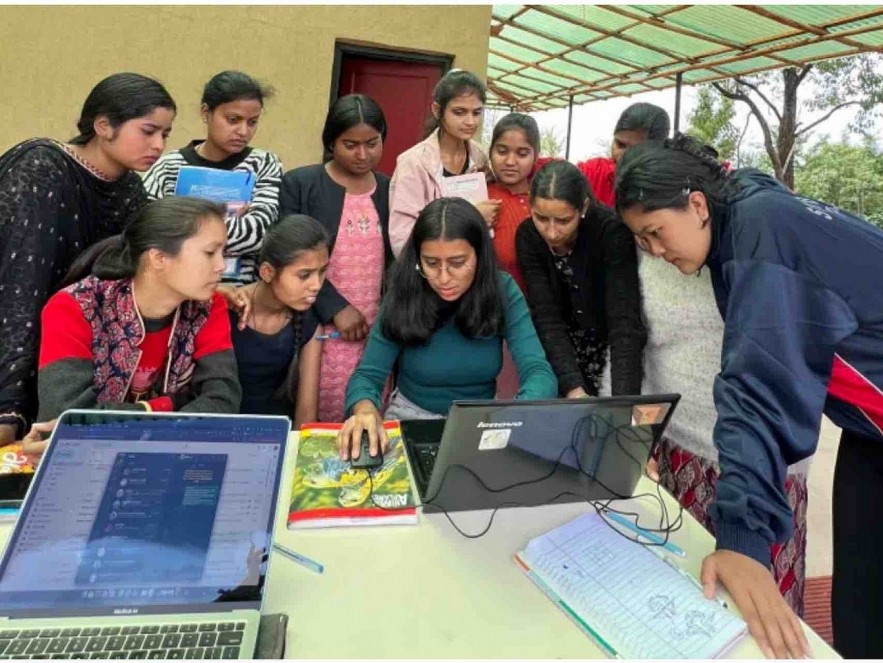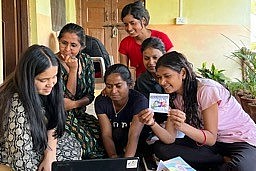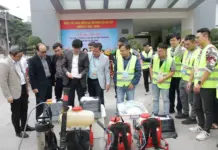 |
| A group of students attend an online coding session at the Sapna Center, a training facility for marginalized women from rural India. [Rishabh Jain/Al Jazeera] |
On a sunny morning in Kandabari village, located in India’s northern state of Himachal Pradesh, a classroom full of students is engrossed in a coding lesson.
Among them is 19-year-old Kriti Kumari, one of 31 women enrolled at the Sapna Center. The center provides training for rural women from marginalized backgrounds, requiring them to reside on campus. The year-long program equips women with coding and website design skills, project management techniques, and primary-school-level math education for those aspiring to become teachers. The organization also assists individuals in securing jobs within India’s thriving information technology sector.
“If it weren’t for the Sapna Center, I’d likely be married by now, tending to household duties,” revealed Kumari, a native of the central Indian state of Jharkhand, who has been at the center for the past four months. She further shared with Al Jazeera that while her brother opposed the idea of her pursuing studies due to financial constraints, her father supported her educational ambitions and accompanied her to the center.
The Sapna Center is operated by Sajhe Sapne, a nonprofit organization established in 2020 by 32-year-old Surabhi Yadav. Yadav is an alumnus of the prestigious Indian Institute of Technology (IIT) in Delhi. Since its inception, the center has successfully graduated 90 students.
For young women like Kumari, acquiring coding and programming skills opens doors to India’s $250 billion IT industry. This sector employs over five million people, with women comprising 36 percent of the workforce. Landing a job in this field is Kumari’s aspiration upon completing her course, despite the challenges she has faced along the way. Prior to enrolling, she had never heard the term “coding” and initially struggled to grasp the concept.
Yadav attributes language barriers as one of the primary reasons why women from rural areas may struggle to excel in STEM courses. She elaborates, “If you can’t understand the meaning of the word ‘coding,’ how can you be expected to learn it?”
At Sajhe Sapne, the educational background of the students, affectionately known as “Sapnewaalis,” is not the primary concern. Instead, interested individuals are required to pass an entrance exam that assesses their English language proficiency and reasoning abilities. The teaching staff, mindful of the diverse linguistic backgrounds of the students, employs local languages such as Bundelkhandi, Maghi, Bhojpuri, or Hindi to instruct coding languages like HTML, CSS, and JavaScript.
Muskaan, a program manager at Sajhe who goes by a single name, has been with the organization for the past two years. She firmly believes that language is the cornerstone of their pedagogical approach. To illustrate their unique teaching methodology, Muskaan explains, “We use terms like ‘abracadabra,’ ‘rat,’ and ‘gili gili chu’ to help students grasp the fundamental concepts of coding.” These words and phrases, drawn from childhood stories and cartoons popular in Indian villages, serve as relatable anchors for the students’ understanding.
Even the training session aimed at introducing tools like LinkedIn, Microsoft Excel, and Word deviates from conventional nomenclature. Instead of “career intelligence,” they’ve coined the term “pehelwaani.” Derived from the words “pehel,” meaning initiative, and “wani,” conveying determination, this term encapsulates the attitude and capacity to take initiative and persist in problem-solving.
This innovative approach to education has empowered the women to devise solutions to challenges faced in their villages. Yadav recounts the story of former student Anjani Kumari from Baghmara village in Uttar Pradesh. Anjani utilized her newfound skills to teach her brother how to use Google Sheets for logging irrigation services and managing payments for their farm. Additionally, she introduced a digital system at the village government-run creche for tracking data on children using the service and their families.
 |
| Surabhi Yadav, the founder of Sajhe Sapne, aims to train at least 20,000 women in the next five years. [Rishabh Jain/Al Jazeera] |
Defying the Odds
Preeti Kumari, a native of Bihar (one of India’s poorest states), shared her journey to becoming a student at the center with aspirations to become a web developer. She learned about this opportunity from a relative, but her parents initially refused to support her endeavors. “Enrolling in the Sapna Center meant going against my family’s wishes,” Kumari recounted. With the help of her brother, who booked her train ticket, assisted with packing, and escorted her to the center, she took a bold step forward. It took a month for her parents to come around and accept her decision.
In Bihar, the dropout rate after grade 10 is a concerning 42 percent, ranking among the highest in the country. Early marriages are still prevalent across India, with 41 percent of women marrying before the age of 19. Consequently, many young women never have the opportunity to pursue higher education.
The women at the Sapna Center have navigated social boundaries, stood firm against parental objections, and, in some cases, even escaped early marriages. Kriti Kumari, for instance, faced pressure from her parents to marry, but the wedding was called off due to disagreements over the dowry. Reflecting on this turning point, she shared, “The day my marriage was canceled, I asked my friend to help me fill out the application form to join Sajhe Sapne.”
Although Kriti successfully passed the entrance exam for Sajhe, it took her three months to convince her parents to allow her to enroll. Yadav acknowledged that many of the girls who come to study at Sajhe often encounter resistance from their families, whether due to marriage expectations or concerns for their safety.
Kajal Ufhade, an 18-year-old student studying project management, shared her experiences growing up in an unprivileged caste community in Punjab. She often faced discrimination at school, where teachers maintained a distance and refused to correct her notebooks. As a result of this ostracization, Ufhade dropped out after seventh grade in 2020. However, the organization that had funded her school fees intervened and persuaded her parents to allow her to join the Sapna Center.
Ufhade proudly stated, “We are among the first girls in our community to pursue higher education.” She and three other young women from her village are now role models for their community. Ufhade recalled her father’s words as she left home to join Sajhe: “Ab aaogi to angrezi seekh kar aana,” translating to “When you come back, make sure you know how to speak English.”
 |
| Students at the Sapna Center perform a play in English, showcasing their language skills and confidence. [Rishabh Jain/Al Jazeera] |
Vision for the Future
Yadav’s inaugural cohort in 2020 comprised 25 students, including women from the Musahar community in Bihar, one of India’s poorest and most socially ostracized castes. Her initial crowdfunding goal was to raise 1.5 million rupees ($18,000), but within just three days, she had surpassed that target, raising 2.6 million rupees ($31,000). The support came not only from family and friends but also from celebrities who noticed and retweeted her initiative.
Since then, she has secured multiple grants from social enterprises, including Nudge and Meta, Social Alpha, CINI, and Wingify, among others. Yadav has set her sights on training at least 20,000 women in the next five years. To achieve this goal, she intends to focus on one or two geographical areas to catalyze a substantial social shift in the expectations for rural women. However, she acknowledges that realizing this vision will require significant investment, a challenge she is currently navigating.
The year-long residential program at the Sapna Center incurs a cost of $1,146 per trainee. Yadav is contemplating the idea of establishing non-residential centers that can accommodate 20 to 25 women from a village at a time. While this concept is still in its infancy, Yadav is exploring the possibility of engaging her graduates with the “Each One, Teach One” initiative. She requests that alumni pay the fee for an incoming student, just as someone once supported them. Her overarching goal is to foster a robust alumni network that becomes the primary source of investment, influence, and inspiration for future students.
In a pilot initiative, Yadav has approached the families of current students, requesting those with financial means to contribute a monthly fee of $24 to support the center’s funding needs. However, she recognizes that to make a more significant impact, collaboration with government programs and schemes will be essential for long-term sustainability.
Navigating Rejections
The Sapna Center boasts an impressive 75 percent employment rate, with graduates securing jobs in project management, technical fields, and primary school math teaching positions. However, the path to employment has not always been smooth for these graduates. Some, like Simran (who goes by a single name), faced multiple rejections during their job search while studying at the center.
This raises the question of the employability of Sapna Center graduates. Bhavna Arora, deputy manager of employee development at an IT company in Delhi, asserted that educational background plays a significant role in the hiring process. “No organization would consider candidates who have only completed the 10th or 12th grade,” she stated, adding that larger companies typically seek graduates with IT-related degrees.
Yadav disagrees with this sentiment, arguing that a lack of a degree does not equate to a lack of skills. She highlights the challenges faced by graduates of non-premier engineering schools in finding employment and attributes the issue to the overall quality of education and the scarcity of jobs. For Sapna Center students, the more significant hurdle lies in the hiring processes, which are often not designed with diversity and inclusion in mind.
When Sajhe Sapne reaches out to organizations for placements, they advocate for skills-based assessments rather than a rigid adherence to paperwork. “If you believe that our Sapnewaalis possess the necessary skills, then hire them,” Yadav implores prospective employers.
Rather than discouraging Simran, the rejections fueled her determination. Along with a handful of other women who faced similar setbacks, she decided to forge her own path by starting Udyami Technologies, a business offering web and app development services. This month, they have secured five projects worth $2,500. Their plans include registering the company officially and inspiring more rural girls to pursue careers in the tech field.
Learning through heritage
NDO – Van Mieu (Temple of Literature) attracts a large number of student visitors every year, mainly for spiritual purposes. How do the young people who come to the Van Mieu in hopes of understanding and respecting the true value of the heritage make the most of their experience? A programme on studying though heritage has been initiated in some primary schools in Hanoi and the results look good.
Uncovering Le Anh Vinh’s Love for Math
In 2013, Dr. Le Anh Vinh was the youngest-ever Vietnamese to be appointed associate professor at the age of 30. Vinh is known as a talented mathematician and a fervent education administrator who has inspired a love for mathematics for younger generations. His new teaching methods bring Vietnam closer to the world’s modern education systems.








